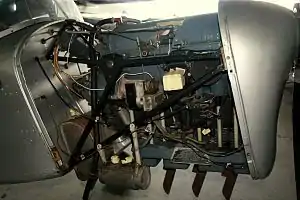Blackburn Cirrus Major
The Blackburn Cirrus Major is a British, inline-four aircraft engine that was developed in the late 1930s.
| Cirrus Major | |
|---|---|
 | |
| Right side view of a Cirrus Major III installed in an Auster J/5G | |
| Type | Air-cooled 4-cylinder inline piston engine |
| National origin | United Kingdom |
| Manufacturer | Blackburn Aircraft |
| First run | 1936 |
| Number built | c.700 |
Design and development
The Blackburn Cirrus Major started life as a continued evolution of the original Cirrus and Hermes series of aircraft engines which had been in production for the last decade. C. S. Napier, son of engine designer Montague Napier, was Technical Director and Chief Designer for Cirrus-Hermes Engineering when he began work on two new engines, the Cirrus minor and the larger Cirrus Major. The engines were still under development when the company was bought by the Blackburn Aeroplane & Motor Company, moved to a new factory at Brough in Yorkshire and renamed Cirrus Hermes Engineering.[1][2]
Like all the Cirrus engines, the Major was an air-cooled inverted four-cylinder inline design. Aimed at the same market for a robust, reliable and affordable light aircraft engine, it retained many proven design features of the originals while making many improvements. Cylinder barrels were of forged steel while the individual heads were of light alloy. Unlike the Minor, the Major retained the established long bolts which passed through the barrels to secure the heads to the crank case, as well as the general layout of the heads from the Hermes IV A, which remained in production alongside. Pistons and con-rods were of light alloys, with a steel crankshaft. Direct drive to the propeller, without reduction gearing, helped to keep engine revs low and reliability high. The single carburettor was a Claudel Hobson AV.48D.[1]
In 1935 the Cirrus Minor entered production and the Major followed soon afterwards. Two years later, with its product range now rationalised and the new engines settled in the marketplace, the company was brought into its parent as the Cirrus Engines Division of Blackburn Aircraft.
Variants

- Cirrus Major I
- 135 hp
- Cirrus Major II
- 148 hp variant.
- Cirrus Major III
- Higher compression engine with an increase in output to 150 hp (116kW).
Applications
- Auster Aiglet
- Auster Autocar
- Blackburn B-2
- Chrislea Skyjeep
- de Havilland DH.60 Moth
- Fairey Primer
- Foster Wikner Wicko
- General Aircraft Cygnet
- General Aircraft Owlet
- HAL HT-2
- Hendy 302
- I.Ae. 31 Colibrí
- I.Ae.32 Chingolo
- Miles Aerovan
- Miles Aries
- Miles Gemini
- Miles Hawk Major
- Miles Hawk Trainer
- Miles Mercury
- Miles Messenger
- Portsmouth Aerocar Major
- Simmonds Spartan
- Stampe SV.4
Specifications (Cirrus Major I)
Data from Lumsden[3]
General characteristics
- Type: Inline air-cooled inverted 4-cylinder
- Bore: 4.72 in (120 mm)
- Stroke: 5.51 in (140 mm)
- Displacement: 385.64 cu in (6.31 L)
- Length: 50 in (1270 mm)
- Width: 17.5 in (444 mm)
- Height: 30 in (762 mm)
- Dry weight: 310 lb (141 kg)
Components
- Valvetrain: 1 inlet and 1 exhaust valve per cylinder
- Fuel system: 1 Claudel-Hobson carburettor
- Fuel type: 73 octane petrol
- Cooling system: Air-cooled
Performance
- Power output: 135 hp (101 kW) at 2,350 rpm
- Compression ratio: 5.1:1
- Power-to-weight ratio: 0.43 hp/lb (0.71 kW/kg)
See also
Related development
Comparable engines
Related lists
References
| Wikimedia Commons has media related to Blackburn Cirrus Major. |
Notes
- "The 'Cirrus Major'", Flight, 13 June 1935. Supplement.
- "A New Small Engine", Flight, 28 February 1935, pp.218-9.
- Lumsden 2003, p.89.
Bibliography
- Oldengine.org
- Gunston, Bill (1986). World Encyclopedia of Aero Engines. Wellingborough: Patrick Stephens. p. 40.
- Lumsden, Alec. British Piston Engines and their Aircraft. Marlborough, Wiltshire: Airlife Publishing, 2003. ISBN 1-85310-294-6.